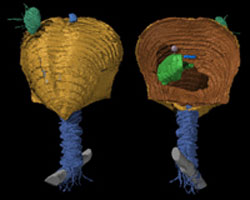Soft body fossils of extinct ’lamp shell’ digitally reconstructed

Lamp Shade’ fossil recovered from 250 million year old Herefordshire, U.K. lava ash
A team of American and British scientists have identified and digitally reconstructed the first example of a fossilized brachiopod complete with its pedicle, the stalk attaching it to the sea floor, and its lophophore or feeding organ, according to a report in the journal Nature.
Brachiopods, the so called “lamp shells,” are rare today, but are some of the best known fossils from the Paleozoic era — 542 to 251 million years ago. Our knowledge of these extinct forms was previously based almost entirely on their shells, which are all that normally fossilize.
Derek Briggs, professor of geology and geophysics, and director of the Yale Institute of Biospheric Studies, with his colleagues Mark Sutton at the Imperial College, University of London, Derek Siveter at University of Oxford and Professor David Siveter at University of Leicester conducted their research on the fossil deposits in Herefordshire, U.K.
This extraordinary trove of fossil records was buried under the sea in volcanic ash that is 425 million years old. The site is unusual because it yields fossils of the entire animals, including soft body parts that the researchers then can reconstruct digitally.
“This specimen is particularly interesting as several smaller brachiopods have attached themselves to its shell, two of them also preserving pedicles,” said Briggs.
The brachiopod belongs to an extinct group, and this work reveals that its pedicle differs from that on living forms. Previous assumptions that extinct brachiopods were very similar to modern examples may thus be too simplistic.
Other specimens of interest from the volcanic ash at Herefordshire that were recently reconstructed by the team include an ancient sea spider and the oldest fossil animal that is “definitively male.” [see Release #1 and #2 below]
Media Contact
All latest news from the category: Earth Sciences
Earth Sciences (also referred to as Geosciences), which deals with basic issues surrounding our planet, plays a vital role in the area of energy and raw materials supply.
Earth Sciences comprises subjects such as geology, geography, geological informatics, paleontology, mineralogy, petrography, crystallography, geophysics, geodesy, glaciology, cartography, photogrammetry, meteorology and seismology, early-warning systems, earthquake research and polar research.
Newest articles

How the Immune System Learns from Harmless Particles
Our lungs are bombarded by all manner of different particles every single day. Whilst some are perfectly safe for us, others—known as pathogens—have the potential to make us ill. The…

Biomarkers identified for successful treatment of bone marrow tumours
CAR T cell therapy has proven effective in treating various haematological cancers. However, not all patients respond equally well to treatment. In a recent clinical study, researchers from the University…

She deciphers how tomato roots communicate
Ora Hazak has always been fascinated by plants and is studying the signals that roots send to the rest of the organism. She aims to understand this communication in order…





















